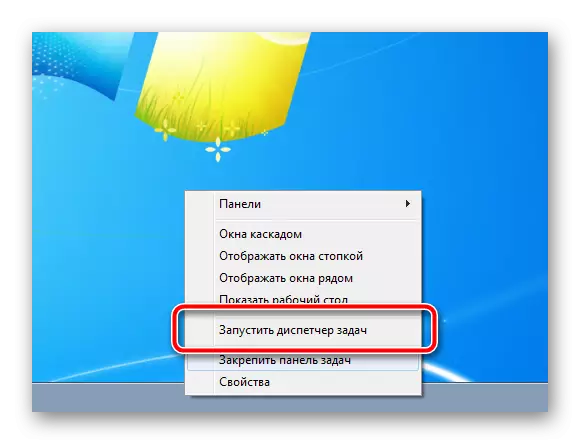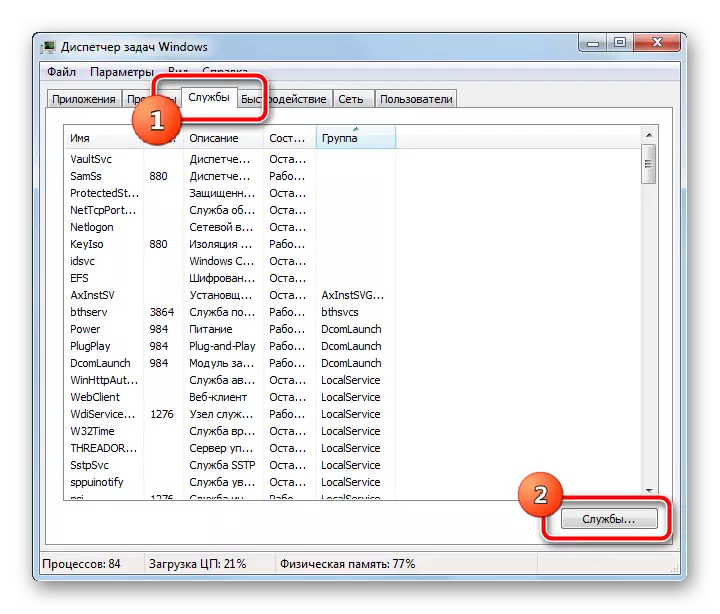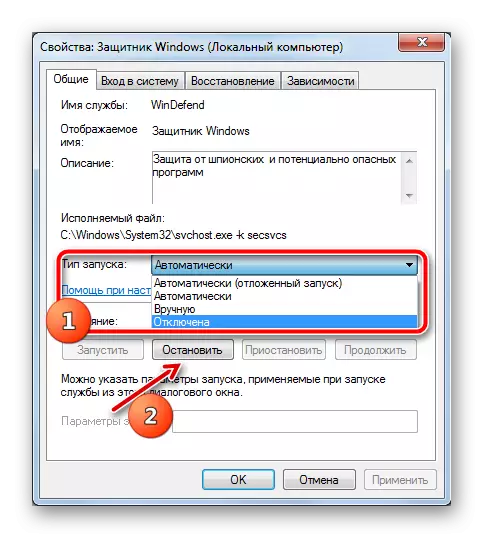
System services in Windows are much more than the needs of the user. They hang in the background, performing useless work, loading the system and computer itself. But all unnecessary services can be stopped and completely disconnecting to unload the system slightly. The increase will be small, but on very weak computers will definitely notice.
Release of RAM and Unloading System
These operations will be subject to those services that perform unclaimed work. To begin with, the article will show the way to turn off, and then a list of recommended to stop in the system. To perform the instructions below, the user must necessarily need a administrator account, or such access rights that will make sufficiently serious changes to the system.Stop and turn off unnecessary services
- Run "Task Manager" using the taskbar. To do this, press it on the right mouse button and select the corresponding item in the context menu that appears.
- In the window that opens, immediately go to the "Services" tab, where the list of working elements will appear. We are interested in the same button, which is in the lower right corner of this tab, click on it once.
- Now we got to the "service" tool. Here, a list of all services is displayed in an alphabetical order, regardless of their condition, which greatly simplifies their search in such a large array.

Another way to get to this tool is simultaneously pressing on the keyboard "Win" and "R" button, in the appeared window in the search bar, enter the Services.msc phrase, and then press "ENTER".
- Stopping and disable service will be shown on the example of "Windows Defender". This service is completely useless if you use a third-party antivirus program. Find it in the list, the shedding of the mouse to the desired item, then on the title, right-click. In the context menu that appears, select "Properties".
- A small window will open. Incidentally in the middle, in the "Startup Type" block, there is a drop-down menu. Open it by pressing the left mouse button and select "Disabled". This parameter prohibits autorun service when the computer is turned on. Low below is a number of buttons, click on the second left - "stop". This team immediately stops the working service, completing the process with it and unloading it from RAM. After that, in the same window, click in a row "Apply" buttons and "OK".
- Repeat items 4 and 5 for each unnecessary service, removing them from autorun and immediately unloading from the system. But the list of services recommended for disconnection is slightly lower.





What services to disable
In no case do not disconnect all services in a row! This can lead to an irreversible collapse of the operating system, partially disconnecting its important functions and loss of personal data. Be sure to read the description of each service in the window of its properties!
- Windows Search. - File search service on a computer. Disable if you use third-party programs.
- Windows archiving - Creating backup copies of important files and operating system itself. Not the most reliable way to create backup copies, really good ways are looking for in the details of this article below.
- Computer browser - If your computer is not connected to the home network or not connected to other computers, then the operation of this service is useless.
- Secondary login - If only one account is in the operating system. Attention, access to other accounts will not be possible until the service is turned on again!
- Print Manager - If you do not use the printer on this computer.
- NetBIOS Support Module via TCP / IP - The service also provides the operation of the device on the network, most often it is not needed by the usual user.
- Public Group Supplier - Again the network (this time only a home group). We also turn off if you do not use.
- Server - This time the local network. Do not use, admit.
- Tablet PC Input Service - A completely useless thing for devices that have never worked with touch peripherals (screens, graphic tablets and other input devices).
- Portable Device Enumerator Service - You are unlikely to use data synchronization between portable devices and Windows Media Player libraries.
- Windows Media Center Scheduler Service - Most forgotten program, for which a whole service works.
- Bluetooth support service - If you do not have this data transfer device, then this service can be removed.
- BitLocker disc encryption - You can turn off if you do not use the built-in partitioning encryption tool and portable devices.
- Remote Desktop Services - An unnecessary background process for those who do not work with their device remotely.
- Smart Map. - Another forgotten service, unnecessary to most ordinary users.
- Themes - If you are a classic style adherent and do not use third-party design themes.
- Remote registry - Another service for remote work, the disconnection of which significantly increases the security of the system.
- Fax - Well, there are no questions, right?
- Windows Update Center - You can disable if you for some reason do not update the operating system.
This is the basic list, disabling the services in which the computer security will significantly increase and unload it a bit. But the promised material that needs to be studied for more competent use of the computer.
Top Free Antiviruses:
Avast Free Antivirus.
Avg Antivirus Free.
Kaspersky FREE.
Data security:
Creating a backup system of Windows 7
Windows 10 Backup Backup Instructions
In no case, do not disconnect the services in the destination of which are not sure. First of all, it concerns the protective mechanisms of anti-virus programs and firewalls (although competently configured means of protection will not allow themselves to disable themselves). Be sure to write to which services you have made changes so that in the event of a malfunction, it was possible to turn on everything back.
On powerful computers, the increase in productivity may not even be noticeable, but more old working machines will accurately slander a slightly released RAM and unloaded processor.
